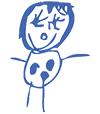EECERA Conference 2025 – Guest Blog # 26: What if innovation were, above all, about relationship?
Posted 21st August 2025
One of a series of short blog posts by presenters who will be sharing their work at the upcoming annual conference in Bratislava, Slovakia. Any views expressed in this post are those of the author(s) and do not necessarily reflect the official stance of their affiliated institution or EECERA.
What if innovation were, above all, about relationship? Interculturality and Robotics in Early Childhood Education
By Alessia Bartolini (Università degli Sudi di Perugia)

Photo by Robo Wunderkind on Unsplash
“At first, I was skeptical… but then I wanted to try.”
This is how one teacher described her experience with the SONRIE project—a research-training initiative that intertwined social robotics, intercultural education, and teacher professional development in early years services. The project took place in multicultural educational contexts increasingly called upon to be spaces of coexistence, deep listening, and mutual recognition.
What happens when technology enters early childhood education settings?
Can it support the creation of meaningful relationships, shared understandings, and a sense of belonging?
And above all, what do we learn about education when we look at it from this new, challenging and inclusive perspective?
The SONRIE project – SOcial eNtertaining Robotics for Intercultural Education – funded through PRIN 2022 PNRR grants, introduced a socially competent robot into 0–6 educational settings not to replace educators, but to activate new spaces for intercultural dialogue and inclusion.
🌍 Embodied interculturality: when identity speaks
“A child was moved to see the Albanian flag.”
This small moment reminds us that identity often surfaces through details—a flag, a word, a sound from home. With SONRIE, these symbols emerged naturally, sparking spontaneous stories. “She answered in French—her father’s language—for the first time.”
Technology here became a threshold—opening, connecting, validating—allowing children to bring their full selves into the group.
🤖 A little one among the little ones
“He was one of them—a little one among the little ones.”
SONRIE was not seen as an outsider or gadget, but as a mediating presence, naturally integrated into classroom life. Especially among quieter, more reserved children, plurilingual children, or those with disabilities, SONRIE facilitated interaction, helped decentralise routines, and built relational and cultural bridges.
🧠 Teacher reflexivity and intercultural postures
“We questioned ourselves. Maybe I was the one who hesitated—the children accepted him immediately.”
The project made space for adult transformation as well. Teachers engaged in reflective practice, questioning their habits and assumptions. The focus shifted from what to do, to how to be—with each other and with diversity. A pedagogical posture of openness and deep listening emerged, valuing difference as a generative force.
🧳 Suitcases full of difference
The metaphor of the suitcase ran throughout the project:
Teachers carried suitcases filled with tools, emotions, and discoveries. Children carried invisible ones—full of scents, stories, languages, songs from home. SONRIE helped open these suitcases: legitimising identities, creating room for storytelling, and making cultural presence visible and valuable.
🕊️ A question that remains
SONRIE invites us to imagine interculturality not as an added task, but as the living fabric of education.
It’s not just about welcoming migrant-background children. It’s about creating environments where every story is heard, shared, and transformed.
What if innovation were, above all, about relationship?
What if a robot could help us see the other not as a problem, but as a resource?
Perhaps the real challenge is not bringing interculturality into educational spaces, but recognising it as already there—alive, embodied, and waiting to be voiced. My aim is to make the themes of inclusion, intercultural dialogue, and socially competent robotics in early childhood education accessible and engaging to a wide audience, and I, alongside my co-author Maria Filomia, look forward to engaging with people about this in Braitslava.
Alessia Bartolini will present work referred to in this blog in Symposium Set F25 (Wednesday, the 27th of August). (Schedule liable to change; please refer to final programme for details).
Alessia Bartolini (Università degli Sudi di Perugia – alessia.bartolini@unipg.it
